Virtual SIM technology is shaking up the way Aussies stay connected, ditching the hassle of swapping tiny plastic cards for something far more flexible. Most people are still carrying physical SIMs in their phones, but the real action is happening behind the scenes. With users now able to switch mobile networks instantly, no physical card needed, this digital shift is changing how we travel, work, and manage devices in everyday life.
Quick Summary
| Takeaway | Explanation |
|---|---|
| Virtual SIMs enable instant network switching | Users can easily switch mobile networks without needing to physically change SIM cards, streamlining connectivity. |
| They support multiple profiles simultaneously | With a virtual SIM, users can store and manage various network profiles, enhancing flexibility for travel or work. |
| Enhanced security through encryption | Virtual SIMs use cryptographic methods for secure network authentication, providing better protection against unauthorized access. |
| Cost-effective for businesses | Virtual SIM technology can reduce mobile infrastructure costs and simplify device management for enterprises, improving operational efficiency. |
| Supports advanced applications in various industries | The technology is poised to enhance connectivity in sectors like IoT, automotive, and healthcare, driving innovation and integration. |
Defining Virtual SIM: The Basics of Technology
A virtual SIM represents a groundbreaking digital technology transforming mobile connectivity, offering users unprecedented flexibility in managing mobile networks without traditional physical SIM card constraints. Unlike conventional SIM cards that require manual insertion and replacement, virtual SIMs provide an embedded digital solution that operates electronically.
Understanding Electronic SIM Technology
At its core, a virtual SIM (or eSIM) is a programmable chip integrated directly into mobile devices, capable of storing multiple mobile network profiles simultaneously. According to GSMA research, this technology enables remote provisioning, meaning users can switch mobile networks or activate international plans without physically changing a SIM card.
The fundamental mechanism of virtual SIM technology involves:
- Storing encrypted network credentials digitally within the device
- Allowing remote configuration and management of mobile network profiles
- Supporting instant network switching without physical card replacement
Technical Architecture and Functionality
Virtual SIM technology operates through sophisticated software and hardware integration.
The embedded SIM chip communicates with mobile networks using standardized protocols, enabling seamless profile downloads and authentication. This approach eliminates physical SIM card limitations, providing users with more dynamic and adaptable connectivity options.
For travelers and international users, this means exploring our guide on buying SIMs online can now be even more convenient. The virtual SIM represents a significant leap in mobile telecommunications, offering unprecedented convenience and flexibility in network management.
The Importance of Virtual SIM in Modern Communication
Virtual SIM technology has emerged as a transformative solution in modern communication, revolutionizing how individuals and businesses manage mobile connectivity. By transcending traditional telecommunication boundaries, virtual SIMs offer unprecedented flexibility and efficiency in network management.
Global Connectivity and Flexibility
Research from NCBI highlights that virtual SIMs enable seamless international communication by allowing users to switch between mobile networks without physical SIM card limitations. This technological advancement provides critical benefits for travelers, remote workers, and global businesses seeking streamlined communication solutions.
Key advantages of virtual SIM technology include:
- Eliminating roaming charges through local network profile selection
- Enabling instant network switching without hardware changes
- Supporting multiple network profiles simultaneously
Economic and Operational Efficiency
Beyond individual convenience, virtual SIMs represent significant cost reduction and operational optimization for enterprises. Companies can learn more about international SIM strategies to leverage these technological innovations.
The economic impact extends across various sectors, reducing mobile infrastructure costs and simplifying device management. Businesses can remotely configure and manage device connectivity, dramatically reducing administrative overhead and enhancing operational agility.
As communication technologies continue evolving, virtual SIMs stand at the forefront of a more connected, flexible, and efficient global communication ecosystem.
How Virtual SIM Works: Key Processes and Components
Virtual SIM technology represents a sophisticated digital infrastructure that transforms traditional mobile network interactions through advanced software and hardware integration. Unlike physical SIM cards, virtual SIMs operate through complex electronic processes that enable seamless network management and connectivity.
Network Profile Management
According to GSMA standards, virtual SIM technology relies on a robust digital ecosystem where mobile network profiles are securely stored and remotely managed. The core mechanism involves cryptographically secured digital profiles that can be downloaded, installed, and switched without physical intervention.
Key technical components of virtual SIM profile management include:
- Secure remote SIM provisioning protocols
- Encrypted network authentication mechanisms
- Dynamic profile configuration capabilities
- Standardized communication interfaces between devices and mobile networks
Authentication and Security Protocols
The authentication process for virtual SIMs is significantly more advanced compared to traditional SIM technology. Each digital profile contains unique encrypted credentials that validate network access, ensuring robust security and preventing unauthorized connectivity.
For travelers seeking flexible connectivity solutions, exploring multi-country SIM strategies becomes easier with virtual SIM technologies. Sophisticated encryption algorithms protect user data and network credentials throughout the profile management lifecycle, providing enhanced security compared to physical SIM alternatives.
By integrating advanced software protocols with hardware-level security, virtual SIM technology creates a more intelligent, adaptable, and secure mobile communication infrastructure.
Comparing Virtual SIM with Traditional SIM Cards
The evolution of mobile communication technology has introduced significant differences between virtual SIMs and traditional physical SIM cards. While both serve the fundamental purpose of network connectivity, their underlying technologies, functionalities, and user experiences differ substantially.

Physical Infrastructure and Design
According to telecommunications research, traditional SIM cards are physical plastic cards containing a removable chip, requiring manual insertion and replacement in mobile devices. In contrast, virtual SIMs are embedded electronic chips integrated directly into device hardware, eliminating the need for physical manipulation.
Key differences in physical design include:
- Traditional SIMs require manual handling and can be lost or damaged
- Virtual SIMs are permanently integrated into device motherboards
- Physical SIM cards have size limitations, while virtual SIMs leverage device hardware
- Traditional SIMs need physical replacement for network changes
Network Management and Flexibility
Virtual SIM technology offers dramatically enhanced network management capabilities. Users can switch mobile networks instantly without physical card replacement, providing unprecedented flexibility for travelers and international users. Explore our comprehensive guide on international SIM options to understand the practical implications of these technological advancements.
Traditional SIM cards are constrained by physical limitations, requiring manual network changes and carrier-specific cards. Virtual SIMs transcend these restrictions by enabling remote network profile downloads, multiple network profile storage, and instantaneous switching between different mobile operators.
As mobile communication continues evolving, virtual SIM technology represents a significant leap forward in connectivity, offering more intelligent, secure, and adaptable network management solutions.
To help clarify the differences between traditional SIM cards and virtual SIM technology, the table below compares their core characteristics and user experience aspects.
| Feature / Aspect | Traditional SIM Card | Virtual SIM (eSIM) |
|---|---|---|
| Physical form | Removable plastic card | Embedded chip within device |
| SIM management | Manual insertion & replacement | Remote provisioning & management |
| Network switching | Requires a new physical SIM/card swap | Instant, remote network switching |
| Profile support | Usually supports only one active profile | Can store multiple profiles at once |
| Susceptibility to damage/loss | Can be lost, damaged, or misplaced | Not removable, integrated in device |
| Security features | Standard security via chip | Advanced encryption & secure protocols |
| Size limitations | Varying (mini, micro, nano) | No size constraints |
| Suitable for multiple industries | Mainly consumer mobile | IoT, automotive, healthcare, more |
The Future of Virtual SIM Technology and Its Applications
Virtual SIM technology stands at the forefront of a transformative communication revolution, promising unprecedented connectivity and technological integration across multiple sectors. As digital transformation accelerates, virtual SIMs are poised to reshape how devices communicate and interact in an increasingly interconnected world.
Emerging Applications and Industry Impact
According to GSMA research, virtual SIM technology is set to drive significant innovations across various industries. The technology’s flexibility and robust security features make it particularly attractive for sectors requiring dynamic and secure network management.
Promising application domains include:
- Internet of Things (IoT) device connectivity
- Advanced automotive communication systems
- Healthcare monitoring and telemedicine platforms
- Smart city infrastructure management
- Autonomous transportation networks
Technological Evolution and Integration
Emerging virtual SIM technologies will enable more sophisticated network interactions, allowing devices to communicate more intelligently and securely. The integration of artificial intelligence and machine learning with virtual SIM infrastructure could create adaptive network environments that respond dynamically to user requirements.
Explore our comprehensive guide on international connectivity strategies to understand how these technological advancements are reshaping global communication paradigms.
As digital ecosystems become more complex, virtual SIM technology represents a critical infrastructure component, offering scalable, secure, and intelligent connectivity solutions that transcend traditional telecommunication boundaries.

Ready to Experience the Freedom of Virtual SIM?
Are you tired of swapping physical SIM cards every time you travel or need a new mobile plan? As explained in our article, virtual SIM technology gives you instant flexibility, secure remote management, and hassle-free switching between networks. With increasing global mobility and the rise of smart devices, having seamless connectivity without the restrictions of traditional SIM cards is life-changing. Don’t let costly roaming bills or device limitations hold you back from exploring every destination with confidence.

Now is the perfect time to upgrade your travel experience with SimCorner’s trusted digital SIM solutions. Discover how you can enjoy instant network switching and manage multiple profiles with ease. Visit https://simcorner.com now to find the right international connectivity option for your next adventure. Take charge of your communication today to make every trip smarter and simpler.
Frequently Asked Questions
What is a Virtual SIM?
A Virtual SIM, also known as an embedded SIM (eSIM), is a digital technology embedded directly into mobile devices, allowing users to manage multiple mobile network profiles without the need for a physical SIM card.
How does Virtual SIM technology work?
Virtual SIM technology works by storing encrypted mobile network profiles digitally within a device. This enables remote provisioning and allows users to switch between networks without physically changing a SIM card.
What are the benefits of using a Virtual SIM?
Using a Virtual SIM offers several benefits, including eliminating roaming charges by selecting local network profiles, enabling instant network switching, and storing multiple mobile network profiles simultaneously for greater flexibility.
How does Virtual SIM compare to traditional SIM cards?
Virtual SIMs differ from traditional SIM cards in that they are embedded in devices and do not require physical handling. They provide enhanced network management flexibility, allowing users to switch networks remotely, whereas traditional SIM cards require manual insertion and replacement.



